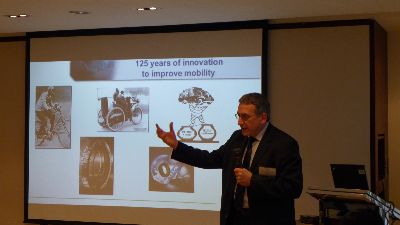How advanced tyres are reducing CO2 emissions

Progress in mobility has translated into progress in numerous areas of activity throughout human history, starting with the invention of wheel all the way through to the latest advances in vehicle technology.
Tyres are often overlooked in terms of their importance to vehicle safety, CO2 emissions and noise. The transportation sector accounts for 24% of global CO2 anthropogenic emissions. Road transport accounts for 18% and tyres alone account for 4.4%. This is equivalent to one out of every tank of fuel for cars and one out of every three tanks of fuel for trucks.
Not all tyres are created equal. There are significant differences in terms of quality of products available on the market. Great technological advances have been made in recent years to improve the quality of tyres and reduce the energy consumption of vehicles using them.
The European Union has introduced a unified system of labeling for vehicle tyres in three categories with respect to their fuel efficiency, rolling sound emissions and their adhesion to wet surfaces. This is the first time that standards have taken into account the impact of tyres on a vehicle's fuel efficiency. The EU's labeling system grades tyres from A-G for the two categories of fuel efficiency and adhesion to wet surfaces (wet grip) and requires a figure for noise emissions in decibels. The new rules apply to tyres sold with new vehicles and the replacement market.
The aim of the new regulations is to help consumers make better-informed choices and promote the wide-spread adoption of the safest and most advanced tyres. Choosing the best tyres can also save consumers money. According to Aimon, consumers can save up to €300 in fuel bills and reduce their CO2 emissions by 500 kilograms over the life of a tyre (approximately 40,000 kilometres) provided that they fit their vehicles with the best tyres (those graded A in terms of fuel efficiency compared to those graded G).
The best tyres in terms of wet grip are much safer because they allowing drivers to stop vehicles faster. When driving at a speed of 80 kilometres per hour, cars fitted with Grade A wet grip tyres can stop approximately 16 metres sooner than cars fitted with Grade F tyres. In terms of noise emissions, the best tyres can be up to four times quieter than their outdated counterparts.
Michelin's goal is to reduce as far as possible the environmental impact of tyres by taking into account every aspect in a tyre's lifetime from production all the way to recycling. By the far the greatest impact tyres have on the environment is during their useful life (owing mostly to CO2 emissions). Reducing rolling resistance is therefore the most important area to focus on to improve overall sustainability.
Great advances have been made in terms of materials used for tyres and design to reduce resistance without compromising on grip. Aimon is confident that there is still plenty of room for improvement. For example, his company is experimenting with taller and narrower tyres to reduce resistance and improve aerodynamics at the same time.
